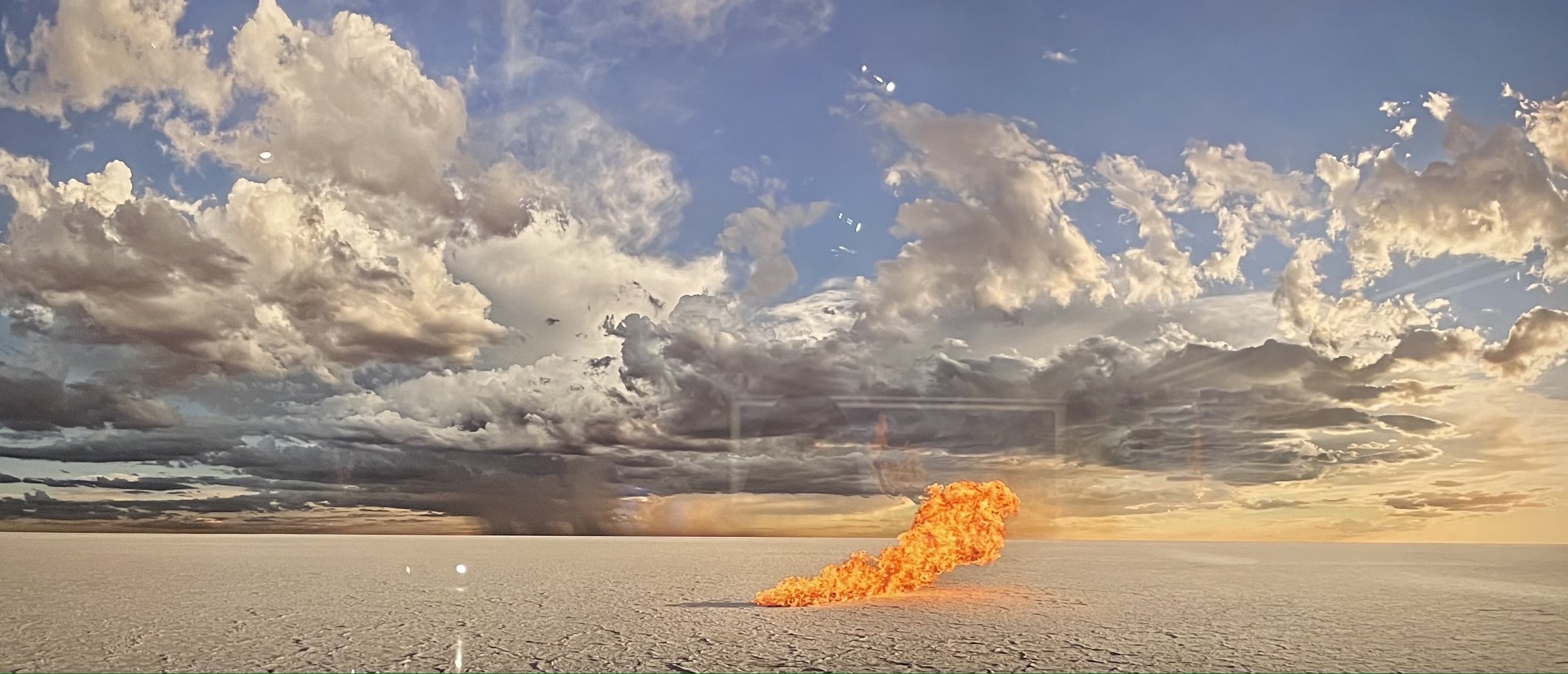Blaze: Murray Fredericks @ Hamiltons Gallery
The first steps inside the Hamiltons Gallery feel like entering a parallel dimension. Lights obfuscate as if approaching a theatre stage, but the visitor is not the star of the show. It is Nature.
Nature as the recognised Australian photographer Murray Fredericks sees it (or how he wants us to see it). Distilling this view are his large-scale photographs, brilliantly illuminated by spotlights that represent the Australian photographer's native landscape. Thanks to their extraordinary atmosphere, these environments seem not natural but, instead, ethereal.
Blaze #10, Lake Pamamaroo, Menindee, 2022. Pigment print mounted to aluminium. 120 x 155 cm. Image: Carolina Lorenzini.
From the beginning of the exhibition, it is clear that “Blaze” is more than a series of photographs depicting beautiful and mesmerising landscapes. Instead, visitors are presented with a vision of the world that encapsulates the power of nature and its fragility.
This sentiment is perfectly illustrated by Blaze #10, Lake Pamamaroo, Menindee (2022). Trees triumphantly burn at the core of the photographs and onto them. But they are not only burning. They are screaming, roaring. In contrast to the foreground, the background is exceptionally peaceful and silent. Furthermore, big flames take shape from the earth's surface, dragging themselves along the deserted space and bursting into the atmosphere with force. Violet hues colour the horizon at the exact point where the sky and earth magically meet and where the reflections on the transparent body of water start to branch out.
Blaze #12, Salt Lake, Muloorina, 2022. Pigment print mounted to aluminium. 60 x 150 cm. Image: Carolina Lorenzini.
Fredericks was born in Sydney, Australia, in 1970 and has spent a lifetime creating a deep relationship with nature that continues to inspire his work as a photographer. Throughout his career, he has always been fascinated by the Australian salt desert. This interest began as early as the 2007 photographic series “Salt”. For the occasion, he travelled to Lake Eyre sixteen times and camped alone in the desolated space. Here he discovered the marvel of nature by staring at it and succeeded in capturing its extraordinary simplicity through his camera lens.
Ten years later, in 2017, Fredericks completed his “Vanity” series, which sees several mirrors unusually positioned in the middle of the desert. Taking the title literally, he used the series as a catalyst to awaken humans from their enchantment on themselves and make them realise their own“Vanity”. Ultimately, he aimed to address human’s gaze toward the real subject to be observed and contemplated: nature.
What strikes me about "Blaze" is that the artist doesn't limit his artistic activity to capturing a particular moment in which the essence of nature spoke to him. Instead, he intervened in the space. The originality of this series is found in the artist’s modification of the subject by adding a natural element: fire. Standing in front of the blazing nature depicted by Fredericks, emotions of fear or worry about the burning trees were not at play. Instead, pure power and magnificence attracted me to the work of art. Behind the scenes on display at Hamiltons Gallery, there is an entire process to be investigated and a methodology introduced by Fredericks that offers a novel perception of nature.
Blaze #9, Lake Pamamaroo, Menindee, 2022. Pigment print mounted to aluminium. 112 x 300 cm. Image: Carolina Lorenzini
One fundamental and unique element within the exhibition is a video documentary providing insight into Fredericks' creative process to realise “Blaze”. Whilst not officially a part of the photographic series, it allows visitors to understand the photographs within the space better. In this video, Fredericks is shown exploring the diverse woodlands and sandy planes to find the ideal location to capture his photographs. Like a movie director crafting a silver screen performance, he meticulously analysed the sky to get the perfect colours, and he carefully measured the height of the trees as they were actors to be selected for a role.
One exciting moment was his affixing flexible gas lines to the backs of dead trees so they would ascend the trunks and wind through the bare branches out of camera range. Pyrotechnical specialists in film industries use this technique, allowing the trees to burn for a short period, preventing them from being damaged by the fire. In allowing visitors to explore behind the scenes, Fredericks enables one to better emotionally identify with the photographs without taking part in them physically.
Blaze#11, Frome Creek, Muloorina, 2022. Archival pigment print. DIMENSIONS Image: Carolina Lorenzini.
Within the gallery, the atmosphere is surprisingly intimate and private, allowing for a deeper connection with the artworks to be established. Incredibly absorbing and unexpectedly distant, the realities intercepted by Fredericks’ camera demand full attention. He does not present suffering nor desolation - only a fire that impressively burns.
Work by work, a different horizon is opened, a different experience is possible, and a new scenario emphasises the intense limitlessness of nature. Yet, only a tiny portion of the environment is exposed through Fredericks' lens, inviting further exploration of our surroundings. Rationally visitors are conscious of being inside the walls of Hamiltons Gallery. However, the infinity that can be perceived by staring at those blazing trees in the middle of the Australian salt pan is subconsciously brought to the fore.
Reflecting on Fredericks’ incredibly dense staged environments, the desire to be a part of his fluorescent blaze continues to burn, and a greater understanding of nature will be scorched into this reviewer’s mind.
“Blaze” is on view at the Hamiltons Gallery in London until January 21, 2023.
References:
Hamiltons, “Murray Fredericks: Blaze,” last accessed December 19, 2022, https://www.hamiltonsgallery.com/exhibitions/147/overview/
“Blaze” is on view at Hamiltons Gallery in London until January 2023.
Carolina Lorenzini
Reviews Co-editor, MADE IN BED





